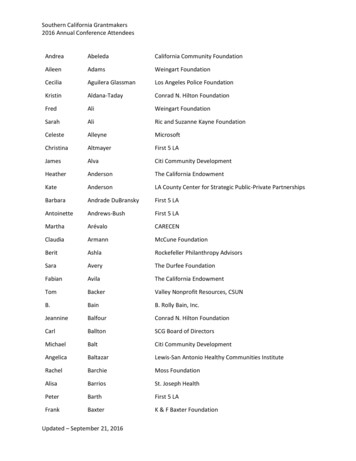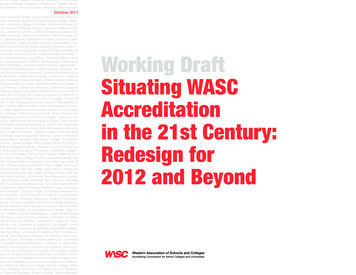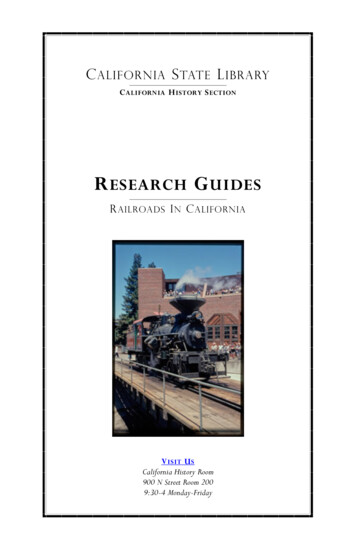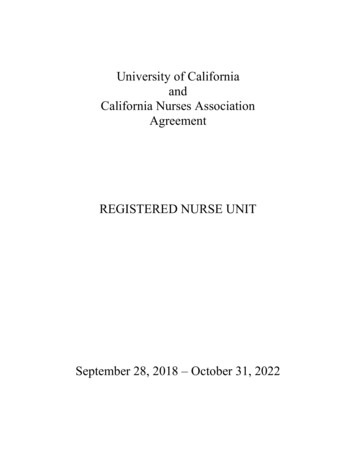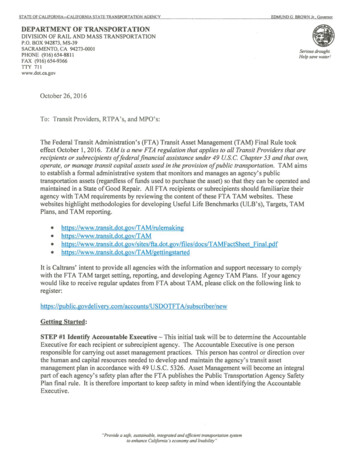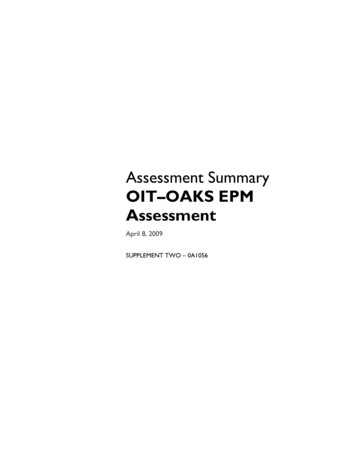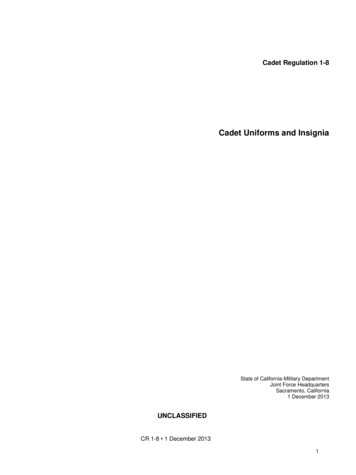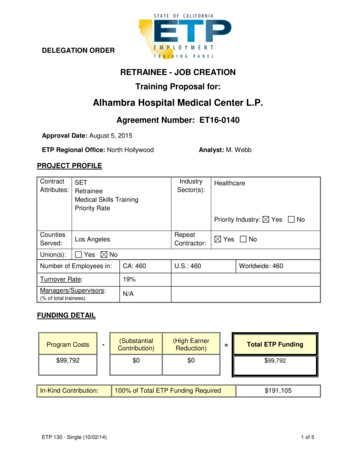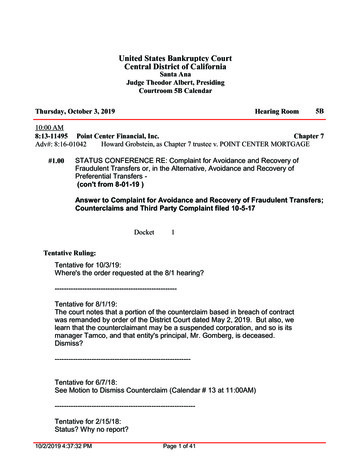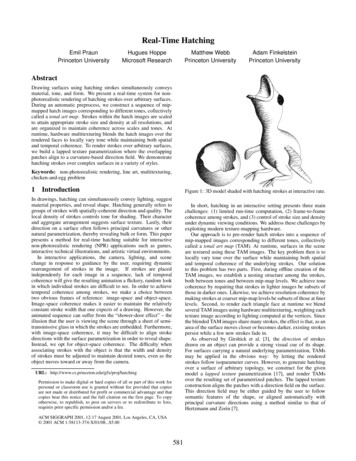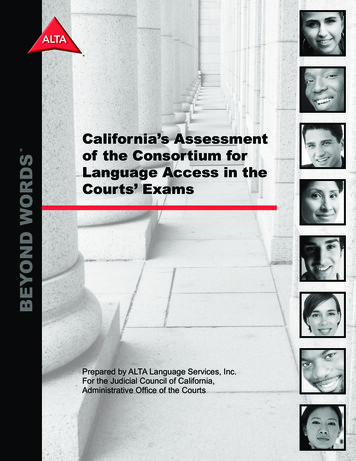
Transcription
BEYOND WORDSM California’s Assessmentof the Consortium forLanguage Access in theCourts’ ExamsPrepared by ALTA Language Services, Inc.For the Judicial Council of California,Administrative Office of the Courts
Assessmen t of t he Co nso rtiu m for L an guageA cc ess in the C ourts’ Test D evelopment r oce ssesThis report is produced for the Judicial Council of California, Administrative Office of the Courts,455 Golden Gate Avenue, San Francisco, CA 94102-3688, www.courtinfo.ca.govCopyright 2010 by Judicial Council of California/Administrative Office of the Courts. All rights reserved.Prepared for the Judicial Council of California by ALTA Language Services, Inc., 3355 Lenox Road,Suite 510, Atlanta, GA 30326Except as permitted under the Copyright Act of 1976 and as otherwise expressly provided herein, no part of this publication may bereproduced in any form or by any means, electronic, online, or mechanical, including the use of information storage and retrievalsystems, without permission in writing from the copyright holder. Permission is hereby granted to nonprofit institutions to reproduceand distribute this publication for educational purposes if the copies credit the copyright holder.For additional information, please contact:Lucy Smallsreed, ManagerCourt Interpreters Program,Executive Office Programs Division,Administrative Office of the Courts455 Golden Gate AvenueSan Francisco, CA 94102-3688courtinterpreters@jud.ca.govThis report is also available on the California Courts Web site: inted on 100% recycled and recyclable paper.California’s Assessment of the Consortium for Language Access in the Courts’ Exams
California’sAssessment of theConsortium forLanguage Access inthe Courts’ ExamsPrepared by ALTA Language Services, Inc.For the Judicial Council of California,Administrative Office of the Courts
California’s Assessment of the Consortium for Language Access in the Courts’ ExamsAssessmen t of t he Co nso rtiu m for L an guageA cc ess in the C ourts’ Test D evelopment r oce sses
In May of 2009, the Judicial Council of California, Administrative Office of the Courts (AOC) contractedALTA Language Services, Inc. (ALTA) to assess the Consortium for Language Access in the Courts’ (CLACor Consortium) examinations for certifying member state court interpreters.The purpose of this assessment was to determine the level of functional equivalency between California’scourt interpreter certification examinations and the Consortium’s exams, and to determine how Californiacould use Consortium exams if comparable testing standards were established.ALTA was charged with analyzing Consortium test content and identifying the overall strengths andweaknesses of the Consortium testing program. Additionally, ALTA examined the degree to which theknowledge, skills, and abilities required of a California court interpreter are covered by the Consortiumexams.With the full cooperation of Consortium staff, ALTA conducted a rigorous and thorough assessment of theConsortium’s exams for certifying court interpreters as well as a comprehensive comparative analysis ofCLAC’s and CCIP’s exam programs. ALTA has found that the CCIP and CLAC exams are comparablein structure, content, and level of difficulty, and that both programs certify interpreters at the same highstandards. The results of this study provide a strong basis for California to adopt Consortium exams in thefuture.Sincerely,Chris Roosevelt, Ph.D.Vice-President of Testing and TrainingALTA Language Services, Inc.ALTA Language Services, Inc.3355 Lenox Road, Suite 510Tel404.920.3800Atlanta, GA 30326Fax404.920.3801www.altalang.com Email info@altalang.comtudy of California’s Court Interpreter Certification and Registration Testing. ANALYSIS OF WORK Q UAL IFICATIONSf o r wa r d
California’s Assessment of the Consortium for Language Access in the Courts’ ExamsAssessmen t .oft he Co nsortiu m for L anATIONSguageANALYSISWORK QUAL IFICA cc ess in the C ourts’Test OFD evelopmentr oce sses
Executive Summary.1Introduction: Project Scope and Deliverables.71 Assessment of the Consortium for Language Access in the Courts’ TestDevelopment Processes. 111.1 Methodological Approach of the Assessment of the ConsortiumTest Development Processes.121.2 Findings of the Assessment of the Consortium Test Development Processes.121.3 Analysis of Findings of the Assessment of the Consortium Test Development Processes.191.4 Conclusions Regarding the Assessment of the Consortium Test Development Processes.191.5 Recommendations from the Assessment of the Consortium Test Development Processes.192 Comparative Analysis of the California Court Interpreter ProgramExams and the Consortium for Language Access in the Courts’ Exams.212.1 Methodological Approach of the Comparative Analysis of the California Court InterpreterProgram Exams and the Consortium for Language Access in the Courts’ Exams.222.2 Findings of the Comparative Analysis of the California Court Interpreter ProgramExams and the Consortium for Language Access in the Courts’ Exams.222.3 Analysis of Findings of the Comparative Analysis of the California Court InterpreterProgram Exams and the Consortium for Language Access in the Courts’ Exams.272.4 Conclusions Regarding the Comparative Analysis of the California Court InterpreterProgram Exams and the Consortium for Language Access in the Courts’ Exams.292.5 Recommendations from the Comparative Analysis of the California Court InterpreterProgram Exams and the Consortium for Language Access in the Courts’ Exams.30Appendices.31Appendix 1 – List of Acronyms.32Appendix 2 – Glossary of Testing Terminology.33Appendix 3 – Interview Questions.34Appendix 4 – KSAs Essential for Court Interpretation.43Appendix 5 – KSAs Measured by the California Written Exam .44Appendix 6 – KSAs Measured by the Consortium Written Exam.45Appendix 7 – KSAs Measured by the California Oral Exam.46Appendix 8 – KSAs Measured by the Consortium Oral Exam.47Appendix 9 – Brief History of the Federal Court Interpreter Certification Exam .48Appendix 10 – Comparison between the Federal Court Interpreter CertificationOral Exams and the Consortium’s Oral Exams.50Appendix 11 – Description of Consortium Scoring Unit Categories.52Appendix 12 – Standard Distribution of Scoring Units for Consortium Oral Exams.54Appendix 13 – California and Consortium Written Certification Exam Comparison.55Appendix 14 – California and Consortium Oral Certification Exam Comparison .56Appendix 15 – Description of Recommended Standard-Setting Approaches.58Appendix 16 – Literature Review.59California’s Assessment of the Consortium for Language Access in the Courts’ ExamsAssessmenof ENTSt h e Co n sortium for L anguagetABLE OFinCtthONTAccesse C ou rts ’ Test Deve lopment rocesse sTa b l e o f C o n t e n ts
California’s Assessment of the Consortium for Language Access in the Courts’ ExamsAssessmen t of t he Co nso rtium for LCanguagetABL E OF rONT ENTSA cc ess in the C ourts’ Test D evelopmentocesses
Executive Summary
EXEC U TIVE SU MMARYI.Purpose of StudyThe Judicial Council of California, Administrative Office of the Courts (AOC) contracted ALTA LanguageServices, Inc. (ALTA) to assess the Consortium for Language Access in the Courts’ (CLAC or Consortium)examinations for certifying member state court interpreters. This study was conducted to establish thelevel of functional equivalency between California’s court interpreter certification assessments and theConsortium’s assessments, as well as to develop recommendations for standard-setting of the Consortiumassessments that would ensure the same passing level of competency required of a candidate to passthe California assessments. (For a complete list and explanation of acronyms referenced throughoutthis Report, see Appendix 1.) Results of analyses from the study also were to establish whether theConsortium’s interpreter certification assessments met the standards required of California interpretercertification assessments and, if not, what improvements could be made to achieve those standards.II. BackgroundThe Consortium for Language Access in the Courts has created a comprehensive interpreter certificationtesting program that encompasses both an English-only written examination and a bilingual oralperformance examination, modeled after the Federal Court Interpreter Certification Examination (FCICE),in more than a dozen languages. The California Court Interpreter Program (CCIP) also consists of a writtenscreening examination and an oral performance examination for certified court interpreters.1 Both writtenexaminations score candidates based upon theirability to correctly answer a variety of multiple-choicequestions. Oral performance examinations for bothOral performance examinations forCCIP and CLAC test the three modes of interpretingboth CCIP and CLAC test the threerequired of a court interpreter: the simultaneousmode, the consecutive mode, and sight translation.2modes of interpreting required of aAdditionally, oral test script development for eachcourt interpreter: the simultaneousprogram is very similar. (For a detailed chart comparingeach program’s oral exam structure and content,mode, the consecutive mode, andsee Appendix 14.) For oral exams, California usessight translation.a combined scoring method that includes a holisticevaluation of language and interpreting skills in additionto objective scoring units, while the Consortium strictlyuses objective scoring units.3“”III.MethodologyVarious methodological steps were taken to examine the process used by the Consortium to develop itstesting tools, and to present a comparative assessment of the exams used for certifying court interpretersby both CCIP and CLAC. These steps included the following:A. Literature and Document Review: Literature pertaining to industry standards for valid testdevelopment was reviewed in addition to documentation provided by Consortium staff anddocumentation found on the Consortium’s website (see Appendix 16).B. Qualitative Interviews: ALTA conducted interviews with Consortium key staff members as well asformer and current language consultants and exam writers.1232Currently, California has certification examinations in 12 designated languages: Arabic, Eastern Armenian, Cantonese, Japanese,Korean, Mandarin, Portuguese, Russian, Spanish, Tagalog, Vietnamese, and Western Armenian. Interpreters of American SignLanguage are eligible to become certified California court interpreters if they hold the Specialist Certificate: Legal granted by theRegistry of Interpreters for the Deaf (RID). Non-designated languages are referred to as registered languages. Interpreters ofregistered languages must pass an English proficiency exam (both written and oral).Simultaneous interpretation is the mode in which the interpreter lags slightly behind the source language speaker, interpreting themessage into the target language at almost the same time as the original message is being said. In consecutive interpretation,the interpreter listens to a unit of speech (approximately 40-60 words at a time) in the source language and then conveys thatmessage into the target language. Sight translation is the oral interpretation of a written document.According to the Consortium’s Court Interpreter Oral Examination: Test Construction Manual (TCM), scoring units are linguisticphenomena that interpreters must be able to render to deliver a complete and accurate interpretation.California’s Assessment of the Consortium for Language Access in the Courts’ Exams
D. Test Content Review: An in-depth assessment of CLAC’s written and oral test content wasconducted by a panel of SMEs.E. Comparative Analysis of Test Programs: Results from the Study of California’s Court InterpreterCertification and Registration Testing4 (Study 2007) were compared to the test content reviewconducted of the Consortium exams; the extent to which the CCIP and CLAC test programs aresimilar and/or different was assessed.F.Psychometric Audit: A psychometric evaluation5 of the Consortium test content framework andstandards was performed by a team of psychometricians and compared to current test industrystandards.G. Standard-Setting Session: A standard-setting session was conducted by a panel of thirteen SMEsto establish the level of functional equivalency between the passing requirements of each program’soral examinations.IV.Executi ve su mmaryC. Federal Court Interpreter Test Development Review: ALTA examined documentation regardingthe test development process and structure of the FCICE in comparison to CLAC’s test developmentprocess and structure. (For a brief history of the development of the Federal Exam, see Appendix 9.)FindingsFindings of the research conducted to assess the Consortium’s test development process and determinehow the Consortium’s process compared to test industry standards include the following: The Consortium has created a comprehensive interpreter testing program with an impressive body oftechnical manuals;nConsortium exam content has been constructed based on solid and consistent test developmentprocesses that respect test industrystandards with a few areas in needof improvement;nThe Consortium has created anduses a Court Interpreter OralExamination: Test ConstructionManual (TCM), which provides atransparent blueprint for Consortiumoral exam development andpromotes test equivalency acrosslanguages and test versions;n Many aspects of the Consortium’soral exams were modeled afterthe Federal interpreter certificationexams; andnThe Consortium employs highlyqualified subject matter experts atevery stage of the process of testdevelopment.n45In June of 2006, the Administrative Office of the Courts of California contracted for an analysis of the examination processand testing instruments for the certification and registration of California state court interpreters. The results and finalrecommendations of this analysis were concluded in 2007, and the report based upon those results and recommendations isreferred to as Study 2007.A psychometric evaluation is conducted by testing experts to document and assess a testing program’s test blueprints andspecifications, as well as any available statistical analyses.California’s Assessment of the Consortium for Language Access in the Courts’ Exams3
EXEC U TIVE SU MMARYFindings from the comparative analysis of CCIP and CLAC exams conducted include:While the constructs of the written exams for each program are somewhat different, they both servethe same function at very similar levels of difficulty: eliminating unqualified candidates from moving onto the oral exam phase of the certification process, while allowing qualified candidates to proceed inthe process;The structure, content, and level of difficulty of the oral exams for CCIP and CLAC are comparableand adhere to equivalent standards;One essential difference between CCIP and CLAC exams is the method of scoring used by eachprogram for its oral examinations: CLAC uses only objective scoring units, while CCIP uses acombination of holistic and objective scoring methods;A high degree of overlap exists between CCIP and CLAC’s written and oral exam KSAs; andAll of the KSAs required in the area of Interpreting Skills are tested by both CCIP and CLAC.nnnnnV.AnalysisAn analysis of findings determined that most areas of the Consortium interpreter certification programmeet test industry standards, while a few are in need of improvement to meet test industry standards.Modeling the Consortium oral exams after the Federal oral exams, which have legally been shown to bevalid (Arjona, 1985), provided the Consortium with a strong foundation for oral test development. TheConsortium’s development and use of the TCM and an objective scoring method has further facilitatedthe development of a consistent and transparent method of achieving test validity during each stage oftest development for every language for which the Consortium develops an interpreter certification test.CLAC’s key areas of strength lie in the qualifications ofpersonnel involved in test development, its objectivemethod of oral exam scoring, and its use of the TCM.CLAC’s key areas of strength lieCLAC’s key areas for improvement include the needin the qualifications of personnelfor further collection of documentation and oral examstatistical data.involved in test development, its“objective method of oral examscoring, and its use of the TCM.”The comparative analysis of CCIP and CLACexaminations determined that CCIP and CLACwritten and oral exams test candidates at comparablestandards of difficulty and at similar standardsaccording to test validity practices. The one KSA (theability to preserve accuracy) tested by CCIP’s writtenexam that is not tested by CLAC’s is tested in CLAC’s oral examination. KSAs tested by CCIP but nottested by CLAC’s oral exams were identified as speaking skills that are not tested due to CLAC’s objectivemethod of scoring. The use of objective scoring units does not allow for an evaluation of subjectivecomponents, such as the testing of a candidate’s pronunciation or accent in the foreign language. In fact,the Consortium considers scoring elements such as foreign language accent difficult to test in an objectivemanner and therefore specifically avoids testing KSAs that cannot be measured through objective scoring.Poor speaking skills will, however, indirectly impact a candidate’s score if raters cannot hear or understanda response given on the oral exam.VI.ConclusionsALTA’s conclusions of the findings and analyses are that, since its inception in 1995, CLAC has created acomprehensive interpreter certification testing program with an impressive body of technical manuals andcandidate resources. CCIP and CLAC have many comparable testing elements and both programs havecreated exams at similar standards and levels of equivalency. In particular, the oral exams of each programcontain many common elements, including types of scripts used and the testing of grammatical structuresand legal terminology. A high overlap of KSAs tested also exists between the CCIP and CLAC written andoral exams; the difference in KSAs is attributable to the distinct methods of scoring used by each program,but all interpreting KSAs adopted by California are tested in CLAC’s exams.4California’s Assessment of the Consortium for Language Access in the Courts’ Exams
VII. RecommendationsIt is ALTA’s recommend
ALTA Language Services, Inc. ALTA Language Services, Inc. 3355 Lenox road, Suite 510 Tel 404.920.3800 Atlanta, gA 30326 Fax 404.920.3801 www.altalang.com email info@altalang.com forwArd. A n ALYSIS OF WO r K Q u ALIFICATIO n S tudy of California’s
